
Gelechioidea is the superfamily of moths that contains the case-bearers, twirler moths, and relatives, also simply called curved-horn moths or gelechioid moths. It is a large and poorly understood '"micromoth" superfamily, constituting one of the basal lineages of the Ditrysia.
Galactosomum is a genus of flukes in the family Heterophyidae. There are currently 28 recognised species within the genus. They mainly infect aquatic birds, but often infest fish as larvae. Three species are known to use marine mammals as hosts.
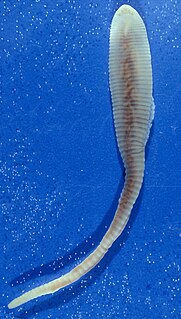
The Pentastomida are an enigmatic group of parasitic arthropods commonly known as tongue worms due to the resemblance of the species of the genus Linguatula to a vertebrate tongue. They are traditionally seen as crustaceans, even if that position has been questioned.

Karl (Carl) Moriz (Moritz) Diesing was an Austrian naturalist and zoologist, specializing in the study of helminthology.

The Boridae are a small family of beetles with no vernacular common name, though recent authors have coined the name conifer bark beetles. They feed on decaying cambium and require forests with standing dead trees and with intensive forest management some species have become rare and threatened.
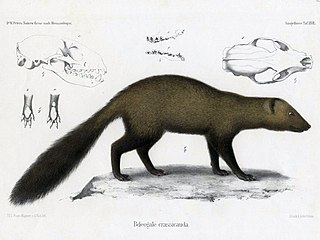
Bdeogale is a mongoose genus that was proposed by Wilhelm Peters in 1850 based on a mongoose specimen collected in Mozambique. Bdeogale species have compact paws with four symmetrical toes, round ears and a blunt muzzle with a broad round and bare rhinarium. The genus contains four species that are primarily terrestrial and omnivorous and forage in dense vegetation.

The Raphidophyceae are a small group of eukaryotic algae that includes both marine and freshwater species. All raphidophytes are unicellular, with large cells, but no cell walls. Raphidophytes possess a pair of flagella, organised such that both originate from the same invagination. One flagellum points forwards,and is covered in hair-like mastigonemes, while the other points backwards across the cell surface, lying within a ventral groove. Raphidophytes contain numerous ellipsoid chloroplasts, which contain chlorophylls a, c1 and c2. They also make use of accessory pigments including β-carotene and diadinoxanthin. Unlike other heterokontophytes, raphidophytes do not possess the photoreceptive organelle typical of this group.
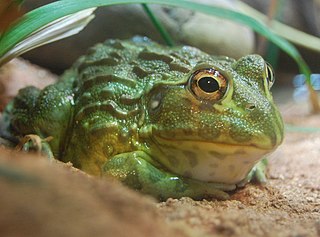
The Pyxicephalidae are a family of frogs found in sub-Saharan Africa.
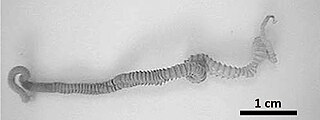
Gigantorhynchus is a genus of Acanthocephala that parasitize marsupials, anteaters, and possibly baboons by attaching themselves to the intestines using their hook-covered proboscis. Their life cycle includes an egg stage found in host feces, a cystacanth (larval) stage in an intermediate host such as termites, and an adult stage where cystacanths mature in the intestines of the host. This genus is characterized by a cylindrical proboscis with a crown of robust hooks at the apex followed by numerous small hooks on the rest of the proboscis, a long body with pseudosegmentation, filiform lemnisci, and ellipsoid testes. The largest known specimen is the female G. ortizi with a length of around 240 millimetres (9.4 in) and a width of 2 millimetres (0.08 in). Genetic analysis on one species of Gigantorhynchus places it with the related genus Mediorhynchus in the family Gigantorhynchidae. Six species in this genus are distributed across Central and South America and possibly Zimbabwe. Infestation by a Gigantorhynchus species may cause partial obstructions of the intestines, severe lesions of the intestinal wall, and may lead to death.

Gonyaulax is a genus of dinoflagellates with the type species Gonyaulax spinifera Diesing. Gonyaulax belongs to red dinoflagellates and commonly causes red tides.

Oligacanthorhynchida is an order containing a single parasitic worm family, Oligacanthorhynchidae, that attach themselves to the intestinal wall of terrestrial vertebrates.

Isodiametridae is a family of acoels.
Proteocephalidae is a diverse family tapeworms with nearly 300 recognized species in 66 genera and 13 subfamilies, whose species are found in every continent. They are mainly parasites of siluriforms and other freshwater fishes, but also parasitize reptiles and amphibians. A typical proteocephalid life cycles include planktonic crustaceans, and small fish as intermediate hosts.
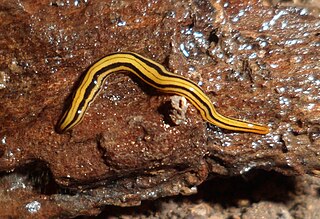
Luteostriata is a genus of land planarians from Brazil characterized by a yellow body with dark longitudinal stripes.

Lagenivaginopseudobenedenia is a genus of monopisthocotylean monogenean, included in the family Capsalidae. The type-species of the genus is Lagenivaginopseudobenedenia etelisYamaguti, 1966. The genus includes only 2 species, which are both parasitic on the gills of marine fish of the family Lutjanidae.

The Capsalidae is a family of monopisthocotylean monogeneans, which includes about 200 species.
Alexandr Vladimirovich Gussev, sometimes spelled Gusev in the literature, was a Russian helminthologist specialist of monogeneans.
Discocotylidae is a family of flatworms belonging to the order Mazocraeidea.
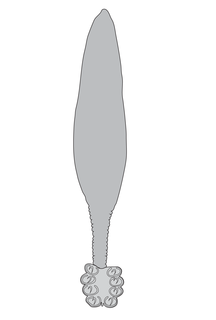
Chimaericola leptogaster is a species of polyopisthocotylean monogenean in the family Chimaericolidae. It is ectoparasitic on the gills of the chimaera Chimaera monstrosa.
Diplectanum is a genus of monopisthocotylean monogeneans in the family Diplectanidae. The genus, created by Karl Moriz Diesing, gave its name to the family Diplectanidae. All its species are parasites of the gill lamellae of teleosts. The type-species of the genus is Diplectanum aequans(Wagener, 1857).













